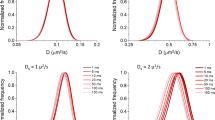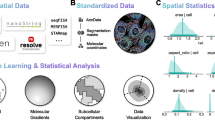Summary
Cell-to-cell interaction and spatial distribution of the heliozoanActinophrys sol was analyzed with computer-aided video microscopy. By means of goodness-of-fit statistics (χ2 analysis) and a quadrat-count analysis (Iδ-curve analysis), the spatial point pattern of the cells was shown to be of regular distribution, which implies that a regulating mechanism is operating to encourage an even spatial distribution of the cell centers ofActinophrys. An attempt was further made to define a unified model which fitsActinophrys cell distribution observed at different cell densities. For this purpose, the fitting of a parameterized potential function φ (r)=(σ/r)12 was carried out, wherer is the distance between cell centers of two neighboring cells. The scaling parameter a was estimated from the maximum likelihood procedure for obtaining the best fit for the data, which was found to be a decreasing function of the cell density; we obtained σ = 0.44 mm at a low cell density (0.5 cell/mm2) and σ=0.10 mm at the highest cell density (6.5 cells/mm2). These results suggest that (1) the possible nearest distance between two neighboring cells is primarily defined by the axopodial length, and (2) at lower cell densities,Actinophrys can recognize the presence of distant neighboring cells by some unknown means.
Similar content being viewed by others
References
Akaike H (1977) On entropy maximization principle. In: Krishnaiah PR (ed) Applications of statistics. North-Holland, Amsterdam, pp 299–311
Diggle PJ (1983) Statistical analysis of spatial point patterns. Academic Press, London
Eberhardt LL (1967) Some developments in “distance sampling”. Biometrics 23: 207–216
Hines WGS, Hines RJO (1979) The Eberhardt statistic and the detection of nonrandomness of spatial point patterns. Biometrika 66: 73–80
Morishita M (1959) Measuring of the dispersion and analysis of distribution patterns. Mem Fac Sci Kyushu Univ Ser E [Biol] 2: 215–235
Ogata Y, Tanemura M (1981) Estimation of interaction potentials of spatial point patterns through the maximum likelihood procedure. Ann Inst Statist Math 33B: 315–338
— — (1984) Likelihood analysis of spatial point patterns. J R Statist Soc B 46: 496–518
— — (1985) Estimation of interaction potentials of marked spatial point patterns through the maximum likelihood method. Biometrics 41: 421–433
Ono Y (1965) On the ecological distribution of ocypoid crabs in the estuary. Mem Fac Sci Kyushu Univ Ser E [Biol] 4: 1–60
Patterson DJ, Hausmann K (1981) Feeding byActinophrys sol (Protista, Heliozoa): 1. Light microscopy. Microbios 31: 39–55
Rogers CA (1964) Packing and covering. Cambridge University Press, Cambridge
Sakaguchi M, Suzaki T, Shigenaka Y (1993) Spatial point patterns ofActinophrys sol and estimation of interaction potentials among cells. In: Abstracts of IX International Congress of Protozoology, Berlin, July 25–31, 1993, p 110
Shigenaka Y, Kaneda M (1979) Studies on the cell fusion of heliozoans IV. An electron microscopical study on the fusion process accompanied with axopodial degradation. Annot Zool Japon 52: 28–39
Suzaki T, Shigenaka Y, Takeda Y (1978) Studies on the cell division of heliozoans II. Active role of axopodia on division process and transformation of remnants of cytoplasmic connecting bridge to new axopodia. Cell Struct Funct 3: 209–218
— —, Watanabe S, Toyohara A (1980) Food capture and ingestion in the large heliozoan,Echinosphaerium nucleofilum. J Cell Sci 3: 231–244
Watters C (1968) Studies on the motility of the Heliozoa I. The locomotion ofActinosphaerium eichhorni and Actinophrys sp. J Cell Sci 3: 231–244
Author information
Authors and Affiliations
Corresponding author
Rights and permissions
About this article
Cite this article
Sakaguchi, M., Suzaki, T. & Shigenaka, Y. Statistical analysis of spatial patterns of the heliozoanActinophrys sol . Protoplasma 196, 117–122 (1997). https://doi.org/10.1007/BF01281065
Received:
Accepted:
Issue Date:
DOI: https://doi.org/10.1007/BF01281065




